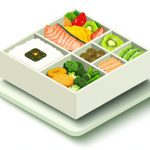Tired of yo-yo dieting? Ready to feel great and energized without feeling deprived? This isn’t about another crash diet – it’s about making small, lasting changes that actually stick. For a structured approach, check out this 30-day challenge. We’ll walk you through simple steps to build healthy eating habits, from understanding your own food relationship to creating a plan that fits your life. Forget restrictive rules; we’ll focus on making food choices that nourish your body and mind. Let’s build a healthier you, one delicious, satisfying meal at a time.
The Foundation: Understanding Your Eating Habits
Before diving into meal plans and grocery lists, let’s take a moment to understand your current relationship with food. This isn’t about judgment, but about gaining valuable insights.
- Food Journaling: For a week, diligently record everything you eat, including the time of day, your hunger level (on a scale of 1 to 10), and your emotional state.
- Identify Triggers: Do you tend to reach for comfort food when you’re stressed? Do you mindlessly snack in front of the TV? Recognizing these patterns is key.
- Analyze Cravings: What foods do you crave most often? Are they usually sweet, salty, or fatty? Understanding your cravings can help you find healthier ways to satisfy them.
- Meal Timing: Are you a breakfast skipper? Do you eat regular meals, or do you graze throughout the day? Irregular meal times can lead to energy crashes and unhealthy snacking.
Building a Balanced Diet: The Core Principles
A balanced diet is the cornerstone of healthy eating. It’s about providing your body with the nutrients it needs to thrive, without deprivation or rigid rules.
1. Embrace the Rainbow: Fruits and Vegetables
- Aim for Variety: Each color represents different vitamins, minerals, and antioxidants.
- Portion Control: Aim to fill half your plate with fruits and vegetables at each meal.
- Snack Smart: Keep pre-cut veggies and fruits readily available for quick and healthy snacks.
- Creative Incorporation: Add spinach to your smoothies, bell peppers to your omelets, or berries to your yogurt.
2. Power Up with Whole Grains
- Choose Wisely: Opt for whole-wheat bread, brown rice, quinoa, oats, and other whole grains over refined grains like white bread and white rice.
- Fiber Boost: Whole grains are rich in fiber, which promotes satiety, regulates blood sugar, and supports healthy digestion.
- Gradual Transition: Start by swapping one refined grain product for a whole-grain alternative each week.
- Read Labels: Look for the word “whole” as the first ingredient on the package.
3. Lean Protein: The Building Blocks
- Essential for Growth and Repair: Protein is vital for building and repairing tissues, maintaining muscle mass, and supporting immune function.
- Choose Lean Sources: Opt for chicken, turkey, fish, beans, lentils, tofu, and low-fat dairy products.
- Portion Size: Aim for a serving of protein that’s about the size of your palm at each meal.
- Versatile Options: Add grilled chicken to your salads, beans to your soups, or tofu to your stir-fries.
4. Healthy Fats: The Essential Nutrient
- Brain Health and Hormone Production: Healthy fats are crucial for brain function, hormone production, and nutrient absorption.
- Smart Choices: Incorporate sources like avocados, nuts, seeds, olive oil, and fatty fish into your diet.
- Portion Control: Be mindful of portion sizes, as fats are calorie-dense.
- Creative Incorporation: Drizzle olive oil on your salads, add nuts to your oatmeal, or snack on a handful of almonds.
5. Limit Added Sugars, Salt, and Unhealthy Fats
- Read Labels Carefully: Be aware of hidden sugars, sodium, and unhealthy fats in processed foods.
- Cook at Home More Often: This allows you to control the ingredients and portion sizes.
- Hydration is Key: Drink plenty of water throughout the day to stay hydrated and avoid mistaking thirst for hunger.
- Moderation is Key: Allow yourself occasional treats in moderation, but don’t make them a daily habit.
Mindful Eating: Cultivating Awareness
Mindful eating is about paying attention to your food and your body’s signals, without judgment. It’s about savoring each bite and being present in the moment.
- Eat Slowly: Chew your food thoroughly and savor each bite.
- Eliminate Distractions: Turn off the TV, put away your phone, and focus on your meal.
- Tune In to Your Body: Pay attention to your hunger and fullness cues. Eat when you’re hungry, and stop when you’re satisfied, not stuffed.
- Ask Yourself: Am I truly hungry, or am I eating out of boredom, stress, or habit?
Crafting Your Personalized Eating Plan
There’s no one-size-fits-all approach to healthy eating. Your plan should be tailored to your individual needs, preferences, and lifestyle.
- Set Realistic Goals: Start with small, achievable goals. Trying to change everything at once is usually overwhelming and unsustainable.
- Meal Planning: Plan your meals for the week in advance. This can help you make healthier choices and avoid impulsive eating.
- Grocery Shopping Strategically: Make a shopping list based on your meal plan and stick to it. Avoid impulse purchases of unhealthy foods.
- Meal Prepping: Prepare meals or snacks in advance. This can save you time and energy during the week.
- Hydrate Regularly: Carry a water bottle with you and sip throughout the day.
- Snack Smart: Keep healthy snacks readily available to avoid unhealthy cravings.
- Be Flexible: Life happens. Don’t beat yourself up if you slip up. Just get back on track as soon as possible.
Seeking Professional Support
If you have specific dietary needs or health concerns, consider consulting a registered dietitian or other qualified healthcare professional. They can provide personalized guidance and support.
Sample Weekly Meal Plan
This is just a sample plan to get you started. Feel free to adjust it to your own preferences and needs.
| Day | Breakfast | Lunch | Dinner | Snacks |
|---|---|---|---|---|
| Monday | Oatmeal with berries and nuts | Salad with grilled chicken and mixed greens | Baked salmon with roasted vegetables | Apple slices with almond butter |
| Tuesday | Greek yogurt with fruit and granola | Leftover baked salmon and vegetables | Lentil soup with whole-wheat bread | Handful of almonds |
| Wednesday | Scrambled eggs with whole-wheat toast | Tuna salad sandwich on whole-wheat bread | Chicken stir-fry with brown rice | Banana |
| Thursday | Smoothie with spinach, banana, and protein powder | Leftover chicken stir-fry | Vegetarian chili with cornbread | Carrot sticks and hummus |
| Friday | Whole-wheat pancakes with fruit | Salad with chickpeas and avocado | Pizza (whole-wheat crust, veggie toppings) | Rice cakes with avocado |
| Weekend | Flexible, but prioritize healthy choices | Flexible, but prioritize healthy choices | Flexible, but prioritize healthy choices | Flexible, but prioritize healthy choices |
Long-Term Success: Consistency and Patience
Establishing healthy eating habits is a journey, not a destination. It takes time, effort, and consistency. Be patient with yourself, celebrate your progress, and don’t give up!
Key Takeaways
* Small steps, big changes: Lasting transformations come from consistent, manageable adjustments.
* Know thyself (and thy cravings): Understanding your eating patterns and triggers sets the stage for success.
* Balance is key: A colorful plate with fruits, vegetables, whole grains, lean protein, and healthy fats is your foundation.
* Mindful moments matter: Savor each bite and tune in to your body’s signals.
* Personalize your path: Create a plan that fits your life, not the other way around.
* Don’t be afraid to ask for help: Professionals can provide tailored guidance and support.
- Glass Lunch Box Containers Offer Healthy, Leak-Proof Meal Prep - December 21, 2025
- Glass Bento Boxes Offer a Healthy, Eco-Friendly Lunch Solution - December 20, 2025
- Glass Bento Containers Make Packing Lunch Easier and Healthier - December 19, 2025










